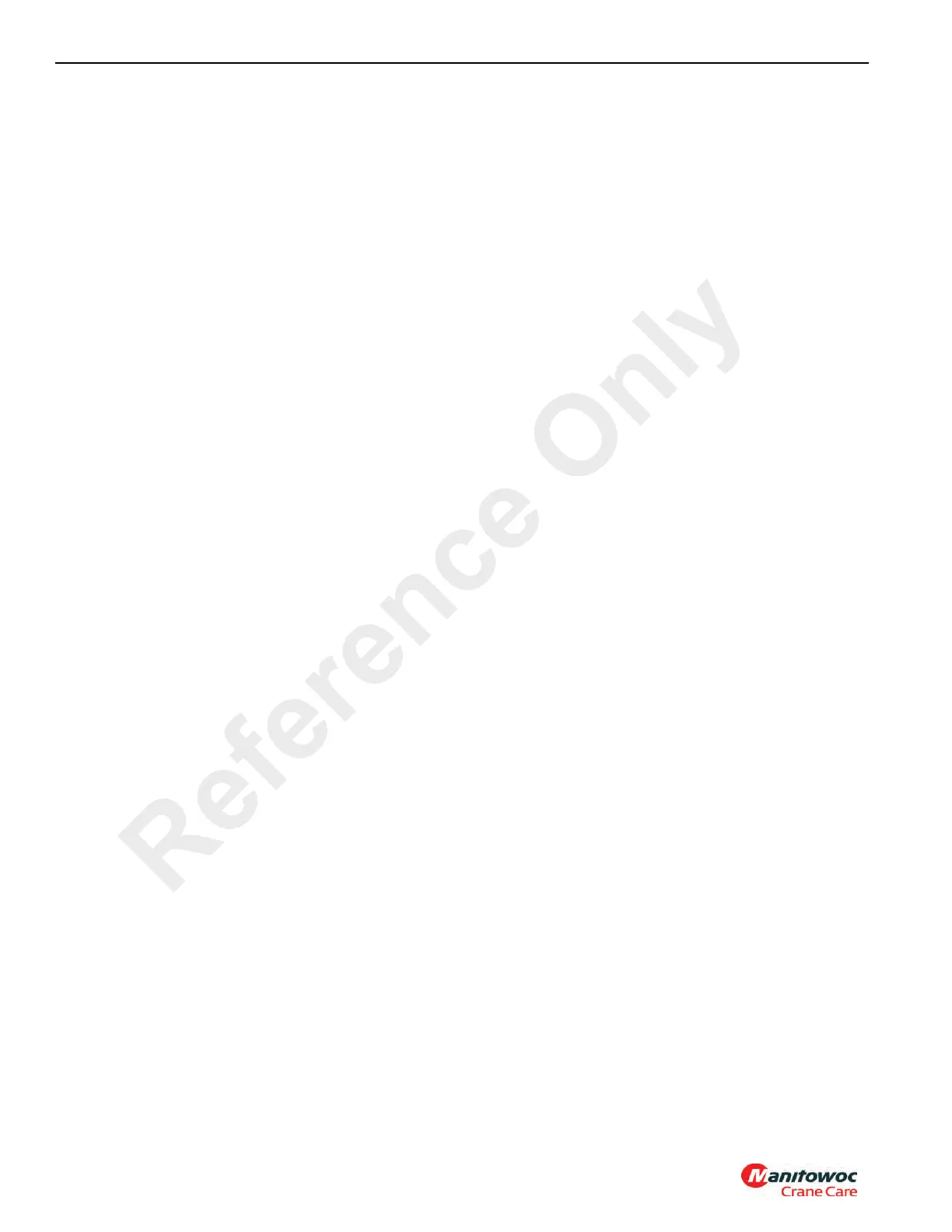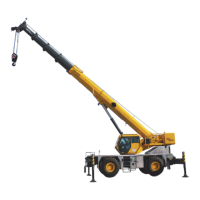8-16
Published 01-29-2014, Control # 496-00
UNDERCARRIAGE TMS800E SERVICE MANUAL
STEER CYLINDER
Description
The steer cylinders are double acting hydraulic cylinders and
are controlled by a steering control valve located in the
steering gearbox. The barrel of each cylinder is attached to
the carrier frame. The cylinder shaft is attached to a steering
arm on the axle spindle. The hydraulic oil entering one end or
other of the cylinder pushes or pulls the tie rod to turn the
wheels left or right.
Maintenance
NOTE: For Disassembly and Assembly of the steer
cylinder, refer to Steer Cylinder, page 2-67.
Removal
1. Tag and disconnect the hydraulic lines to the cylinder.
Cap or plug all lines and openings.
2. Remove the cotter pin, washer, and the retaining nut
from each end of the cylinder.
3. Remove the cylinder.
Installation
1. Install the cylinder in position and secure it with the
attaching nut and washers. Torque the nut to 136 to 170
Nm (100 to 125 lb-ft). Tighten the nut to the nearest
cotter pin hole and install the cotter pin. Add additional
washers as necessary to ensure proper seating of cotter
pin in nut.
2. Connect the hoses as per removal tags.
REAR AXLE AND SUSPENSION
Description
Rear Axle
The rear axles (see Figure 8-11) have single reduction
differentials. The differentials have hypoid drive pinions, ring
gear sets, and bevel gears. A straight roller bearing is
mounted on the head of the drive pinion and all other
bearings are tapered roller bearings. If equipped with a
differential lock, the differential has the same gears and
bearings as the standard differential. An air actuated shift
collar moves toward the center of the differential and when
the splines of the shift collar and axle shafts are meshed the
differential is locked.
Suspension
The rear axle suspension (see Figure 8-11) uses air bags
with walking beams. The air bags along with shock
absorbers are mounted on saddle assemblies above the
walking beams. They provide for cushioning of road shock.
The saddle assemblies are connected at the front by pivot
blocks to carrier mounted brackets. The air bags and shock
absorbers are bolted to the rear of the saddle assemblies
and to carrier mounted brackets. A walking beam center is
attached to each saddle assembly with the ends attached to
each rear axle.
Rubber bushings in the walking beam centers and ends, and
torque rod ends, restrict excessive movement but allows
enough movement to relieve stresses on metal parts. The
rubber joints allow a certain amount of in and out axle
movement which permits each axle to follow its own natural
course more closely through turns. Once a straight line is
resumed, the bushings square off the tandem so that the
leading tires set the tracking pattern. Torque rods along with
the walking beam creates a parallelogram style linkage that
assure positive axle alignment.
Air for the suspension system is controlled by a control valve
on the side console in the carrier cab and by two height
control valves mounted on each side of the frame by the air
bags. Each height control valve is mechanically actuated by
a control lever attached to its respective saddle assembly.
The valve controls the amount of air in each set of air bags
thus controlling the height of the frame. To deflate the entire
air suspension system (front and rear), position the
suspension control valve on the carrier cab right side panel
to deflate. This causes the four height control valves to shift
and dump all air from the suspension air bags. Four pressure
switches sense the air pressure in each set of air bags. Low
air pressure in any of the four sets of air bags will trip the
respective pressure switch to illuminate the deflated
indicator on the side console.
Maintenance
General
Proper preventive maintenance will help control repair costs
and downtime. If a major overhaul is required, remove the
tandem suspension and axle assemblies from the carrier.
However, torque rods, air bags, shock absorbers, walking
beams, and other components can be removed separately
as required with the axles remaining on the carrier. Refer to
Lubrication, page 9-1 for specified lubrication intervals.
Check the torque on all bolts at least once a year.
Beam Center Cap Fasteners
Periodically check the bolts on the saddle cap to prevent
wear of the beam center bushing into the saddle assembly.
Check bolt torque. Torque should be 305 to 372 Nm (225 to
275 lb-ft).
Beam End Connections and Bushings
Every 16,090 km (10,000 mi) check the torque of the beam
end bolts. Torque 610 to 813 Nm (450 to 600 lb-ft). Jack up
under each beam end and check for movement of the rubber
end bushing. Worn bushings will allow movement and the
bushings should be replaced. Periodically inspect the beam
Reference Only

